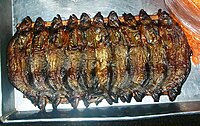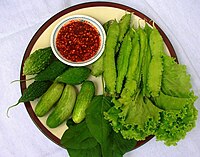en
names in breadcrumbs


Die Asiatischen Fähnchen-Messerfische (Notopterus) sind eine Süßwasserfischgattung aus der Familie der Altwelt-Messerfische (Notopteridae). Sie kommen mit zwei Arten in Südasien vor, Notopterus notopterus lebt in Südostasien im Irrawaddy, Saluen, Mae Nam Mae Klong, Mae Nam Chao Phraya, Mekong und allen Flusssystemen von Thailand, der Malaiischen Halbinsel, Sumatras und Javas und Notopterus synurus kommt auf dem Indischen Subkontinent im Indus, Ganges, Brahmaputra, Mahanadi, Krishna, Kaveri und weiteren Flüssen.[1]
Asiatische Fähnchen-Messerfische werden maximal 60 cm lang, bleiben für gewöhnlich aber bei einer Länge von 25 cm. Der Körper ist seitlich stark abgeflacht, die Rückenlinie gebogen. Wie bei allen Messerfischen bildet die lange, mit der Schwanzflosse zusammengewachsene Afterflosse das Hauptantriebsorgan. Die Flosse besitzt 97 bis 111 Flossenstrahlen. Bauchflossen fehlen. Namensgebend ist die von sieben bis neun Flossenstrahlen gestützte Rückenflosse. Mehr als 200 Schuppen verlaufen entlang der Körperseiten in einer mittleren Längsreihe. Der Vorkiemendeckel hat sechs bis acht Schuppenreihen. Von der Gattung Chitala lässt sich Notopterus durch das konvexe bzw. nur leicht konkave Kopfprofil und durch die Schuppen auf dem Kiemendeckel unterscheiden, die bei Notopterus deutlich größer als die Körperschuppen sind, während sie bei Chitala gleich groß sind.
Jungfische sind braun und zeigen bei einer Länge von weniger als fünf cm auf dem gesamten Körper ein Muster von dunklen Bändern. Ausgewachsene Tiere sind silbrig-grau mit zahlreichen grauen Punkten auf Kopf, Rumpf und Flossen. Die Rumpfoberseite ist dunkler, die Iris glänzt golden.
Asiatische Fähnchen-Messerfische leben in klaren Flüssen, Seen, Kanälen und Teichen und geht auch in leichtes Brackwasser. Während der Regenzeit, in der die Fortpflanzung erfolgt, wandern sie in überflutete Gebiete und kehren während der Trockenzeit in permanente Gewässer zurück. Die Eier werden in kleinen Klumpen zwischen Pflanzen abgelegt. Ein 21 bis 25 cm langes Weibchen legt üblicherweise zwischen 1200 und 3000 Eier. Die nacht- und dämmerungsaktiven Fische ernähren sich von kleineren Fischen, Krebstieren, Insekten und Wasserpflanzen.
Asiatische Fähnchen-Messerfische sind in ihrer Heimat begehrte Speisefische.
Die Asiatischen Fähnchen-Messerfische (Notopterus) sind eine Süßwasserfischgattung aus der Familie der Altwelt-Messerfische (Notopteridae). Sie kommen mit zwei Arten in Südasien vor, Notopterus notopterus lebt in Südostasien im Irrawaddy, Saluen, Mae Nam Mae Klong, Mae Nam Chao Phraya, Mekong und allen Flusssystemen von Thailand, der Malaiischen Halbinsel, Sumatras und Javas und Notopterus synurus kommt auf dem Indischen Subkontinent im Indus, Ganges, Brahmaputra, Mahanadi, Krishna, Kaveri und weiteren Flüssen.
The bronze featherback (Notopterus notopterus; Assamese: কান্ধুলি kandhuli, Bengali: ফলি,Bengali: কাংলা,, Thai: ปลาสลาด, ปลาฉลาด, ปลาตอง, Vietnamese: Cá thát lát, Burmese: ငါးဖယ်) is a ray-finned fish in the family Notopteridae found in South and Southeast Asia. Although primarily found in fresh water, it has been known to enter brackish water.[2] At present, it is the only member of the genus Notopterus,[3] but as currently defined, it is likely a species complex.[1]
Young specimens are a dark bronze-like color that becomes lighter with age. The species reaches a length up to 60 cm (24 in).[2]
The bronze featherback can easily be kept in an aquarium. Popular as food, this fish also appears in a stamp of the Kingdom of Laos.[4]
This fish has been used as food in Southeast Asia since ancient times,[5] and remains an important food item in countries such as Indonesia, Laos, Myanmar (Burma), and Thailand. It is preserved and prepared in different ways.
In Burmese cuisine, the flesh of the bronze featherback, locally known as ngaphe, is used in ngachin, a pressed fish pickle, and is used to make fish paste.[6]
In Thai cuisine, nam phrik pla salat pon (น้ำพริกปลาสลาดป่น) is a variety of nam phrik with minced roasted pla salat eaten along with raw vegetables. It is popular in Khorat.[7] Although much smaller in size, it is similar in appearance to the Chitala ornata, another important fish in Thai cuisine.


The bronze featherback (Notopterus notopterus; Assamese: কান্ধুলি kandhuli, Bengali: ফলি,Bengali: কাংলা,, Thai: ปลาสลาด, ปลาฉลาด, ปลาตอง, Vietnamese: Cá thát lát, Burmese: ငါးဖယ်) is a ray-finned fish in the family Notopteridae found in South and Southeast Asia. Although primarily found in fresh water, it has been known to enter brackish water. At present, it is the only member of the genus Notopterus, but as currently defined, it is likely a species complex.
Notopterus notopterus (bengaleraz: ফলি, thailandieraz: ปลาสลาด, ปลาฉลาด, ปลาตอง) Notopterus generoko animalia da. Arrainen barruko Notopteridae familian sailkatzen da eta hegoaldeko Asiako ur geza eta gazikaretan bizi da. Egun bere generoko kide bakartzat hartzen badute ere, litekeena da espezie-multzo bat izatea.
Notopterus notopterus (bengaleraz: ফলি, thailandieraz: ปลาสลาด, ปลาฉลาด, ปลาตอง) Notopterus generoko animalia da. Arrainen barruko Notopteridae familian sailkatzen da eta hegoaldeko Asiako ur geza eta gazikaretan bizi da. Egun bere generoko kide bakartzat hartzen badute ere, litekeena da espezie-multzo bat izatea.
Notopterus notopterus est une espèce de poissons de la famille des Notopteridae. On le trouve en Asie du Sud-Est, en particulier dans les fleuves Mékong et Chao Phraya. Il mesure 35 cm. C'est un poisson nocturne carnivore qui se nourrit de vers, de poissons, d'invertébrés aquatiques[1]...
Ce poisson est utilisé comme ingrédient principal dans la sauce piquante thaïlandaise Nam phrik pla salat pon.
Notopterus notopterus est une espèce de poissons de la famille des Notopteridae. On le trouve en Asie du Sud-Est, en particulier dans les fleuves Mékong et Chao Phraya. Il mesure 35 cm. C'est un poisson nocturne carnivore qui se nourrit de vers, de poissons, d'invertébrés aquatiques...
Ce poisson est utilisé comme ingrédient principal dans la sauce piquante thaïlandaise Nam phrik pla salat pon.
Notopterus notopterus (Pallas, 1769), conosciuto come Pesce lama[2], è un pesce osseo d'acqua dolce appartenente alla famiglia Osteoglossidae, unica specie del genere Notopterus[3].
Questa specie è diffusa nei bacini idrografici dei fiumi dell'India: Indo, Gange, Brahmaputra, Krishna, Irrawaddy, nonché nei fiumi del Sudest asiatico Meklong, Chao Phraya e Mekong. Popola fiumi, stagni e laghi con acque lente o ferme ma può essere rinvenuto anche in ruscelli con acque chiare o in acqua salmastra. Nel Mekong si sposta nelle aree allagate durante la stagione delle piogge per ritornare nei corsi principali all'inizio del periodo arido[3].
Questa specie ha corpo appiattito lateralmente e piuttosto alto che si assottiglia nella regione caudale. La pinna anale è molto lunga ed è unita alla pinna caudale. La pinna dorsale è piccola e ha un'inserzione molto breve. La testa ha profilo dorsale piatto o solo leggermente concavo (nell'affine genere Chitala questo è visibilmente concavo). L'adulto ha colorazione bruna senza segni o macchie, il giovanile ha alcune fasce scure verticali sul corpo[3].
Raggiunge una lunghezza massima di 60 cm ma la taglia media si aggira sui 25 cm[3].
Notturno o crepuscolare[3].
Si ciba di pesci, insetti, crostacei e anche di materiale vegetale[3].
La riproduzione avviene durante la stagione delle piogge. Le uova vengono deposte di notte, in quantità di alcune migliaia, sulla vegetazione[3].
N. notopterus ha una notevole importanza per la pesca del sud e del sudest asiatico. Viene catturato perlopiù artigianalmente con tutti i sistemi di pesca[3]. È anche oggetto di piscicoltura ma, data la sua alimentazione prevalentemente carnivora, può essere allevato solo in grandi ambienti ricchi di pesce foraggio[1].
N. notopterus è comune in tutto l'areale e non sembra risentire di particolari impatti. Per questo motivo la IUCN considera la specie a minimo rischio di estinzione[1].
Notopterus notopterus (Pallas, 1769), conosciuto come Pesce lama, è un pesce osseo d'acqua dolce appartenente alla famiglia Osteoglossidae, unica specie del genere Notopterus.
Paprastoji peiliažuvė (lot. Notopterus notopterus) – kaulaliežuvių (Osteoglossiformes) būrio žuvų rūšis. Paplitusi Pietų ir Pietryčių Azijos upėse.
Vidutinis ilgis 25 cm, didžiausias – 60 cm.
Azijos kraštuose peiliažuvė yra populiarus žūklės objektas, plačiai vartojama vietinėse virtuvėse (ypač Laose, Tailande, Indonezijoje). Veisiama žuvininkystės ūkiuose.